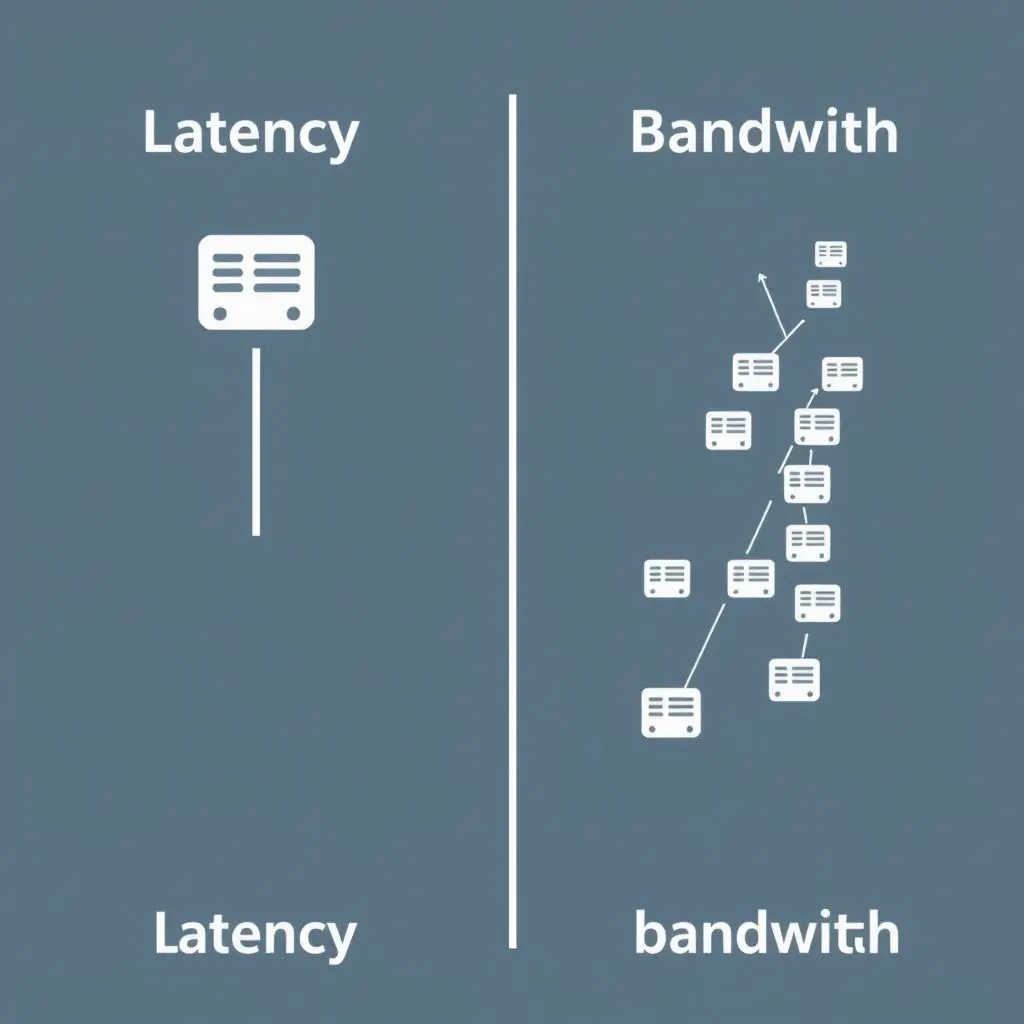Ever stared at your screen, tapping your fingers impatiently as a webpage slowly decides to appear, even though your internet plan promises lightning-fast speeds? Or perhaps you’ve been mid-online game, everything frozen for a maddening second before you’re suddenly defeated? You’re not alone, and the confusion is understandable. While we often talk about ‘internet speed,’ that single term actually lumps together two crucial, but distinct, concepts: Latency and Bandwidth.
It’s not always just about how much data *can* travel, but also about how long it takes for the *first bit* of data to start its journey. Think of your internet connection not just as a pipe, but as a bustling highway system. This analogy can really help untangle these two important ideas.
Table of Contents
Understanding the Highway: Latency and Bandwidth Explained
Imagine the internet as a vast highway stretching from your computer or phone to a server somewhere else in the world (like a website’s server or a game server). Data, in this analogy, is like traffic – the cars, trucks, and buses moving along this highway.
What is Latency? The Initial Delay
In our highway analogy, Latency is the time it takes for the *very first car* to leave your driveway, get onto the highway, and reach its destination. It’s the reaction time of your internet connection. Technically speaking, latency is the time delay before a transfer of data begins following an instruction for its transfer. It’s measured in milliseconds (ms).
Factors that can increase latency include:
- Distance: The further the server is from you, the longer the data has to travel, increasing latency. Data travelling across the globe naturally takes longer than data travelling to a local server.
- Network Hops: Data doesn’t usually travel directly. It passes through multiple routers and servers along the way. Each ‘hop’ adds a tiny bit of delay. More hops mean higher latency.
- Network Congestion: Just like rush hour on a highway, a crowded network can slow down that initial ‘first car’ getting through.
- Type of Connection: Some connection types inherently have higher latency. Satellite internet, for instance, often has much higher latency than fiber optic or cable due to the vast distance the signal travels to space and back.
Why does high latency matter? It’s most noticeable in applications that require quick back-and-forth communication. Online gaming is the classic example; high latency (often called ‘lag’) means your actions take longer to register on the game server, putting you at a disadvantage. Video calls can experience noticeable delays, making conversation awkward. Even loading a simple webpage involves multiple small data requests, and high latency means each request takes longer to initiate, making the page *feel* slow even before the main content starts loading.

What is Bandwidth? The Capacity
Now, let’s look at Bandwidth. Sticking with the highway analogy, bandwidth isn’t about how fast the *first* car gets there; it’s about how *many lanes* the highway has. It represents the maximum volume of data that can travel across the connection *at the same time*. Bandwidth is typically measured in bits per second (bps), kilobits per second (Kbps), megabits per second (Mbps), or gigabits per second (Gbps).
Think of it as the width of the pipe. A wider pipe allows more water (data) to flow through simultaneously. Higher bandwidth means your connection can handle more data requests and transfers concurrently.
Factors related to bandwidth:
- Your ISP Plan: The bandwidth you have is primarily determined by the internet service package you pay for.
- Network Technology: Fiber optic cables generally offer much higher bandwidth than older DSL or dial-up technologies.
- Equipment: Your modem, router, and even the cables in your home can affect the actual usable bandwidth you experience.
Why does high bandwidth matter? It’s crucial for activities that involve transferring large amounts of data. Streaming high-definition video requires significant bandwidth to deliver all those pixels quickly. Downloading large files (like software updates or movies) goes much faster with high bandwidth. If multiple devices in your home are using the internet simultaneously (streaming on a TV, gaming on a console, browsing on a laptop), high bandwidth ensures there are enough ‘lanes’ for everyone’s data traffic without causing congestion and slowing things down for everyone.

Latency vs. Bandwidth: The Critical Difference
Here’s the key distinction: Latency is about the time delay for the start of data transfer (how quickly the conversation *begins*), while Bandwidth is about the amount of data transferred per second *once* the transfer is underway (how much information can be said *simultaneously*).
- Low Latency, Low Bandwidth: The connection reacts quickly, but large transfers take a long time because only a little data can pass through at once. Like a narrow road with no speed limit – cars get going instantly, but there aren’t many of them.
- High Latency, High Bandwidth: It takes a while for data transfer to start, but once it does, large amounts can be moved quickly. Like a super-wide highway, but there’s a long, slow on-ramp (the initial delay). This is often the frustrating scenario where a page takes forever to *start* loading, but then appears all at once.
- High Latency, Low Bandwidth: The worst of both worlds. Slow to start, and slow to transfer data. Like a narrow road with a slow on-ramp.
- Low Latency, High Bandwidth: The ideal for most activities. Quick reaction time and high capacity for data transfer. Like a wide highway with a fast on-ramp.

So, a connection with high bandwidth might be great for downloading a movie (volume), but if it also has high latency, that initial click to start the download might feel sluggish (delay).
Seeing the Difference in Action
Sometimes, seeing an analogy in motion helps solidify the concept. We put together a quick visual explanation of this very idea in a YouTube Short. Take a moment to watch and see the highway analogy come to life:
Understanding the difference between latency and bandwidth empowers you to better diagnose internet performance issues and choose the right internet plan for your needs. If your main complaint is lag in games, you need to focus on minimizing latency. If your issue is slow downloads or buffering video, you likely need more bandwidth.
Common Misconceptions
It’s easy to mix these up! Here are a few common misunderstandings:
- Speed is just bandwidth: As we’ve seen, ‘speed’ is a combination of both. High bandwidth with high latency won’t feel fast for interactive tasks.
- Latency only affects gamers: While gamers are particularly sensitive to it, latency affects any activity requiring quick two-way communication, like video conferencing, remote desktop access, or even rapid browsing.
- More bandwidth reduces latency: Increasing your bandwidth plan doesn’t inherently lower your latency. You can have a 1 Gbps connection with high ping if the server is far away or there are network issues.
Frequently Asked Questions about Latency and Bandwidth
Here are answers to some common questions people have about these two critical networking concepts:
Q: What is a good latency (ping) for gaming?
A: Generally, a ping of 20-50ms is considered excellent for gaming. 50-100ms is acceptable but might feel slightly sluggish in fast-paced games. Over 100ms will likely result in noticeable lag.
Q: What bandwidth do I need for streaming HD or 4K video?
A: For a single stream, Netflix recommends at least 5 Mbps for HD and 15 Mbps for 4K. However, this is just for the stream itself. If other devices are using the connection, you’ll need significantly more total bandwidth to ensure smooth streaming for everyone.
Q: Does a higher bandwidth package lower my latency?
A: Typically, no. Bandwidth is about capacity, while latency is about delay. While a very low bandwidth connection might suffer from increased *perceived* latency due to data queueing, increasing bandwidth doesn’t magically reduce the physical time it takes for data to travel or the number of network hops.
Q: Can I improve my latency?
A: Sometimes. You can’t change the physical distance to a server, but you can try using a wired Ethernet connection instead of Wi-Fi (Wi-Fi adds a small amount of latency), ensure your router is modern and functioning correctly, and check if there’s congestion on your local network. Contacting your ISP if you suspect network issues on their end is also an option.
Q: How can I check my latency and bandwidth?
A: You can use online internet speed test websites (like Speedtest.net, Fast.com, etc.). These tests measure both your download/upload bandwidth and your ping (latency) to a nearby server.
Putting It All Together
So, the next time your internet feels sluggish, take a moment to consider whether the issue is the delay before things start (latency) or the capacity to transfer data once things are moving (bandwidth). Understanding this fundamental difference is key to troubleshooting network problems and making informed decisions about your internet service. It’s not just about the ‘speed limit’; it’s about the entire journey – from getting on the road to how many lanes are available for traffic flow.
Hopefully, breaking down latency and bandwidth using the highway analogy has made these concepts clearer. Happy browsing, streaming, and gaming!




